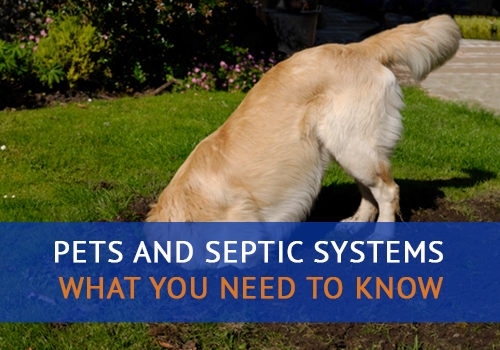
Once installed, you hope never to meet your septic system again except for scheduled maintenance routines. But, remember that bone your dog lost last year. Well, he found it — and the septic system. And that cat litter you flushed is now becoming an issue in the septic tank.
Pets and septic systems bring their own sets of rules and potential problems. But, you can quickly get a handle on them ahead of time, stopping issues down the road.
Pets and Septic Systems Video
Pets and Septic Systems
What do pet hair, cat litter, dog shampoo and digging have in common? None of them mix with septic systems. But, that doesn’t mean pets and septic systems don’t mix — it just means you have to be aware.
Digging
Not just annoying because it destroys your lawn and well-thought out flower bed.
Digging can hurt your septic system and your dog.
If they dig too deep, they can easily access your drainfield. While harder to damage the pipes, they can mess with the soil and gravity-driven system of letting the waste back into the water table.
Not only does this disrupt your septic systems ability to process waste successfully, but it also exposes your dog to waste before fully treated. While dogs are renown for handling (and eating) waste, this is a bit too much.
So, how do you stop the digging?
If you are unable to train your dog to stop digging, considering putting up a fence around your septic system and drainfield to keep your dog away. Or placing mesh over the area to prevent them.
Pet Shampoo & Bathing
While good enough and sensitive enough for your pets, it may not be suitable for your septic system.
Chemicals and harsh cleaners have no place in your septic tank. Including some pet shampoos. So, what should you do? After all, no one likes a smelly pet.
Look for pet shampoos that are septic-safe and chemical-free. This may be especially difficult when using tick and flea shampoos as they contain specific chemicals to rid your pets of bugs. In that instance, an outside wash is your best bet — away from the drainfield.
Pet Hair
Like human hair, pet hair can quickly clog up a system, wreaking havoc and causing back-ups (which then leak into your yard, which further endangers your family pet).
This means using a hair stopper or drain strainer when giving your dog their monthly bath. Additionally, it means no flushing hair down the drain. Use your trash can instead.
Cat Litter
It’s easy to see why people started flushing cat waste down the drain, after all, your septic system processes waste.
But, cat waste is a different animal.
After sitting in cat litter, cat poop petrifies. Becoming solid, cement-like as it works it’s way through your septic system, the bacteria in your septic tank will be hard-pressed to break down.
Additionally, cat waste contains bacteria that your system has not met yet, further disrupting the delicate balance of the required bacteria in your septic tank.
And, never flush cat litter. Think about what would happen if you flushed sand down your pipes. It would sit there accumulating, eventually to the point of needing an early pump-out.
Like flushable wipes, beware of flushable cat litter. Remember, your septic system is designed to handle and process human waste — nothing else.
Pets and septic systems don’t have to be an issue. All it takes is some knowledge and rules, and they get along great.
Have questions? Contact Advanced Septic Services of Florida at 352-242-6100.

